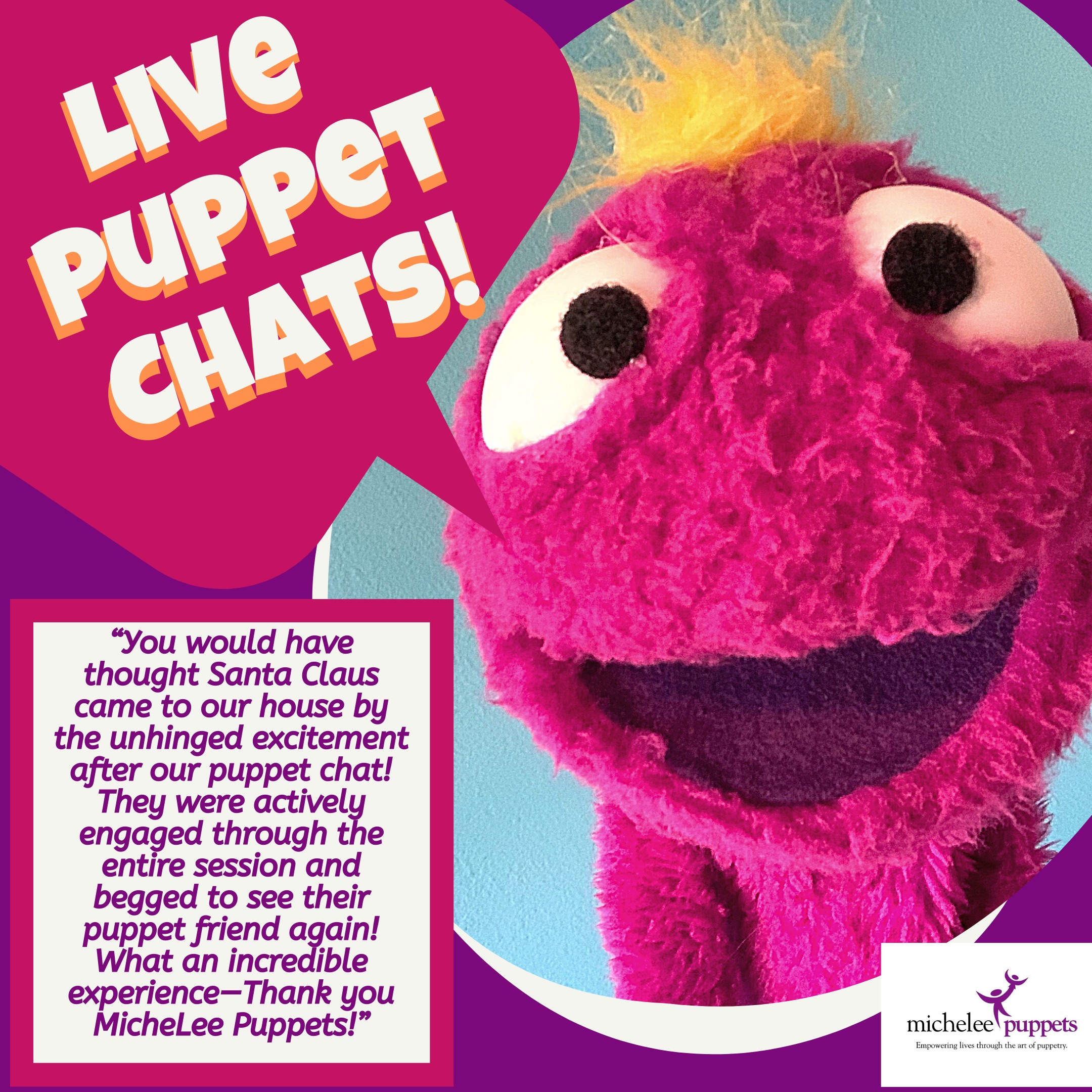According to the U.S. Department of Health and Human Services 1 in 4 U.S. students say they have been bullied and 70.6% of young people say they have been “bystanders” (witnessed bullying). As adults we may find ourselves at a loss for what to say or do, so how do we stop this epidemic? Empowerment is key. When we define bullying and its many forms we can employ strategies and tactics that turn our youth from bystanders into upstanders. MicheLee Puppets uses puppetry as a disarming and relate-able way to convey these messages to students in A Good Day for Pancake (K-2nd grade) and The Upstander League (3-5th grade).
Start the bully prevention conversation with your youth by using DRT– Definition, Roles and Tactics. Make it a game! Role play the different types of bullying to allow your child to practice being an Upstander. Remember, these tactics aren’t just for kids, adults can use them too.
DEFINTION- Define BULLYING:
Bullying is intentional behavior that is repeated or has the potential to be repeated. It creates a real or perceived imbalance of power and is used to harm someone and their reputation. Some examples are:

ROLES- Define ROLES in a bullying situation:
 Person exhibiting bullying behavior
Person exhibiting bullying behavior
Person being Targeted by the bullying behavior
Bystander- someone who witnesses bullying
Upstander- someone who witnesses bullying and does something to stop it
TACTICS- Share these strategies that any bystander can use in a bullying situation

Encourage your child to report in person, so that they can clarify the facts. If they are nervous, reporting can be done in a note, even written anonymously if they fear retaliation.
Why is REPORTING important?
In order to have the proper resources to combat bullying, reporting is essential. Many states report bullying through school INCIDENT RECORDS rather than through student surveys. States then report only a 1% bullying rate. 2 out of 3 schools report 0 cases, and yet according to the The National Center for Education Statistics 21 of every 100 kids ages 12 – 18 are bullied at school. 1 in 10 students cite repeated bullying as the reason they drop out.
 “Be a Friend” is a crucial, especially with social/emotional bullying. This tactic can be one of the most difficult to use because it can mean standing up to friends, however, the more people who use this tactic, the more effective it becomes.
“Be a Friend” is a crucial, especially with social/emotional bullying. This tactic can be one of the most difficult to use because it can mean standing up to friends, however, the more people who use this tactic, the more effective it becomes.
We often hear of “frenemies”, individuals who suddenly exclude or spread rumors about a friend. It is up to bystanders to become upstanders and combat this behavior with friendship.
Whether or not you and the TARGET are friends, you can still “be a friend” by speaking up for the TARGET, including them in groups, and refusing to spread rumors. And, of course, report any bullying behavior to an adult that you trust.
 “Ignore the bully” works especially when groups of people participate. To ignore the bully is not to ignore the situation. Reporting is an essential component. Many people bully because they want to get attention. Simply refusing to be an audience can stop bullying in its tracks.
“Ignore the bully” works especially when groups of people participate. To ignore the bully is not to ignore the situation. Reporting is an essential component. Many people bully because they want to get attention. Simply refusing to be an audience can stop bullying in its tracks.
This tactic is crucial for cyberbullying. Don’t respond online, even if it is to stand up for the TARGET of the bullying. Report the bullying to a trusted adult, then delete.
 Distracting a BULLY can help a TARGET escape a dangerous situation. Talk directly to the bully, even use their name and do something to get their attention.
Distracting a BULLY can help a TARGET escape a dangerous situation. Talk directly to the bully, even use their name and do something to get their attention.
Upstanders can shout something like “Hey (insert bully’s name) the cafeteria’s giving out free ice cream right now!” or “The Principal is coming.” Upstanders can even find funny videos on their device to show the bully or dance around wildly to get their attention. What other distractions can you and your child create?
 Creating an excuse such as “Your Mom is here to pick you up” can help remove a TARGET from a dangerous situation. This technique is especially important to combat physical bullying.
Creating an excuse such as “Your Mom is here to pick you up” can help remove a TARGET from a dangerous situation. This technique is especially important to combat physical bullying.
Be prepared! Practice excuses that can remove a Target from a bullying situation. Think of public locations such as a playground, library, party, etc. and come up with excuses that could apply in each location. Determine which excuses will work in a school setting.
Your child may have questions about lying related to giving excuses. Remind your child that these excuses are for emergency situations (similar to stranger danger) to keep someone from getting hurt.

Standing up can take many forms, but at its essence, it means to tell the bully to stop. People may think of physical violence, such as in “A Christmas Story” when Ralphie, a TARGET of bullying, fights back bloodying the bully’s nose. This is not what we mean. By adding to violence, it puts more people in danger. Words Have Power.
Tell the bully to stop. Get others to do the same. Groups are powerful against bullying. If someone is spreading rumors, verbally bullying someone, or physically bullying them, tell them to stop. Speak with confidence. Then report the bullying to a trusted adult.
RESOURCES
The Upstander League -A Bully Story from MicheLee Puppets on Vimeo. On his first day at a new school, Steven becomes the target of bullying. Instead of helping, his peers join in, leaving Steven feeling powerless. Learn how upstanders can make a difference in a bullying situation by using tactics such as “Be a Friend” and “Stand Up to the Bully.” MicheLee Puppets makes learning fun with shadow puppetry in The Upstander League “A Bully Story.”

Join “The Upstander League”! Learn how to stand up to bullying with “The Upstander League” official handbook! The Upstander League includes everyday citizens, like you, who witness bullying and do something to stop it. With this comic book, you will have the tactics to help stop any bullying situation. Enjoy stories and activities that will take you from witness to Upstander.

REFERENCES
Be informed. Use these resources for more information on bully prevention:
U.S. Department of Health and Human Services
STOMP Out Bullying


 “Kids on the Block,” a disability awareness show, featured full-body, moveable mouth puppets. Puppeteers stood behind the characters, performing scenes and answering questions from the audience. Subjects ranged from physical disabilities, to emotional issues such as dealing with divorce.
“Kids on the Block,” a disability awareness show, featured full-body, moveable mouth puppets. Puppeteers stood behind the characters, performing scenes and answering questions from the audience. Subjects ranged from physical disabilities, to emotional issues such as dealing with divorce. One day, MicheLee Puppets was contacted by a local school. Jacqueè was just starting 3rd grade at their school. She had recently been burned in a fire and they wondered if we had a show that could help introduce this concept to the other students. Tracey grabbed Lynne and off they went.
One day, MicheLee Puppets was contacted by a local school. Jacqueè was just starting 3rd grade at their school. She had recently been burned in a fire and they wondered if we had a show that could help introduce this concept to the other students. Tracey grabbed Lynne and off they went. now use a variety of puppetry styles to convey important messages, but have kept our “Kids on the Block” characters for when they are needed. In fact, our newest show
now use a variety of puppetry styles to convey important messages, but have kept our “Kids on the Block” characters for when they are needed. In fact, our newest show 
 Person exhibiting bullying behavior
Person exhibiting bullying behavior
 “Be a Friend” is a crucial, especially with social/emotional bullying. This tactic can be one of the most difficult to use because it can mean standing up to friends, however, the more people who use this tactic, the more effective it becomes.
“Be a Friend” is a crucial, especially with social/emotional bullying. This tactic can be one of the most difficult to use because it can mean standing up to friends, however, the more people who use this tactic, the more effective it becomes. “Ignore the bully” works especially when groups of people participate. To ignore the bully is not to ignore the situation. Reporting is an essential component. Many people bully because they want to get attention. Simply refusing to be an audience can stop bullying in its tracks.
“Ignore the bully” works especially when groups of people participate. To ignore the bully is not to ignore the situation. Reporting is an essential component. Many people bully because they want to get attention. Simply refusing to be an audience can stop bullying in its tracks. Distracting a BULLY can help a TARGET escape a dangerous situation. Talk directly to the bully, even use their name and do something to get their attention.
Distracting a BULLY can help a TARGET escape a dangerous situation. Talk directly to the bully, even use their name and do something to get their attention. Creating an excuse such as “Your Mom is here to pick you up” can help remove a TARGET from a dangerous situation. This technique is especially important to combat physical bullying.
Creating an excuse such as “Your Mom is here to pick you up” can help remove a TARGET from a dangerous situation. This technique is especially important to combat physical bullying.

